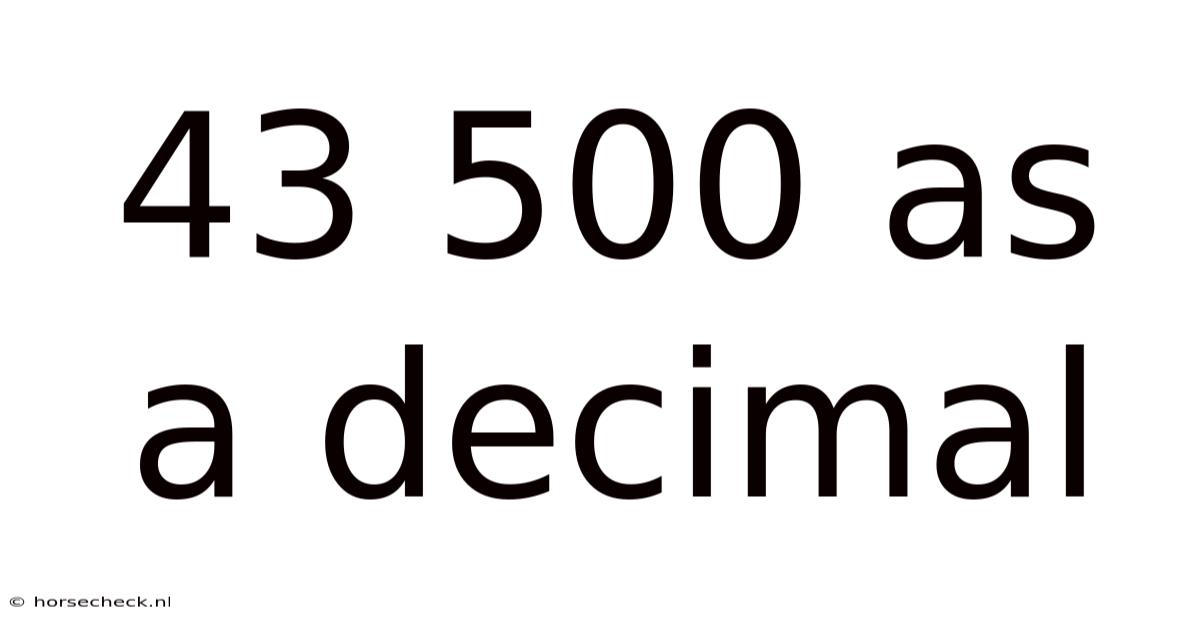43 500 As A Decimal
horsecheck
Sep 23, 2025 · 4 min read

Table of Contents
Understanding 43/500 as a Decimal: A Comprehensive Guide
Understanding fractions and their decimal equivalents is a fundamental skill in mathematics. This article provides a thorough explanation of how to convert the fraction 43/500 into its decimal form, covering various methods and exploring the underlying concepts. We'll delve into the process step-by-step, addressing common questions and offering practical applications. This comprehensive guide aims to equip you with a solid understanding of this essential mathematical conversion.
Introduction: Fractions and Decimals
Before diving into the conversion of 43/500, let's briefly review the relationship between fractions and decimals. A fraction represents a part of a whole, expressed as a ratio of two numbers (numerator and denominator). A decimal is a way of writing a number that includes a decimal point, separating the whole number part from the fractional part. Decimals are essentially fractions where the denominator is a power of 10 (10, 100, 1000, etc.).
Method 1: Long Division
The most straightforward method for converting a fraction to a decimal is through long division. We divide the numerator (43) by the denominator (500).
-
Set up the division: Write 43 as the dividend and 500 as the divisor. Since 43 is smaller than 500, you'll need to add a decimal point and a zero to the dividend (43.000...).
-
Perform the division: Begin the long division process. 500 does not go into 43, so we place a zero above the decimal point. Then, we bring down the zero, making it 430. 500 still doesn't go into 430, so we add another zero and bring it down, resulting in 4300. Now we can perform the division.
-
Calculate the quotient: 500 goes into 4300 eight times (8 x 500 = 4000). Subtract 4000 from 4300, leaving 300.
-
Continue the process: Add another zero and bring it down, making it 3000. 500 goes into 3000 six times (6 x 500 = 3000). The remainder is 0.
Therefore, 43/500 = 0.086
Method 2: Equivalent Fractions
This method involves finding an equivalent fraction with a denominator that is a power of 10. While this might not always be directly possible, it's a useful approach in certain cases. In this instance, we cannot easily convert 500 into a power of 10 through simple multiplication. Therefore, long division remains the more practical method for this specific fraction.
Method 3: Using a Calculator
The simplest method is to use a calculator. Simply input 43 ÷ 500 and the calculator will directly provide the decimal equivalent: 0.086. While this is the quickest way, understanding the underlying process (like long division) is crucial for developing mathematical proficiency.
Understanding the Decimal Result: 0.086
The decimal 0.086 represents eighty-six thousandths. This means that 43 out of 500 parts is equivalent to 8.6% of the whole. This decimal can be used in various applications, from calculating percentages to representing proportions in different contexts.
Practical Applications of Decimal Conversions
Converting fractions to decimals has widespread applications across various fields:
-
Finance: Calculating interest rates, discounts, and profit margins often involve decimal conversions.
-
Science: Many scientific calculations and measurements utilize decimals for precision.
-
Engineering: Engineering designs often require precise decimal measurements for accurate construction.
-
Everyday Life: Percentages (which are closely related to decimals) are frequently used in everyday life, such as calculating tips, sales tax, or discounts.
-
Data Analysis: Representing data as decimals is crucial for data analysis and interpretation.
Frequently Asked Questions (FAQ)
Q: Can all fractions be converted into terminating decimals?
A: No, not all fractions can be converted into terminating decimals. Fractions with denominators that have prime factors other than 2 and 5 will result in repeating decimals (e.g., 1/3 = 0.333...).
Q: What if the long division process doesn't end with a remainder of 0?
A: If the long division results in a repeating decimal (e.g., 0.333...), you can represent it using a bar over the repeating digit(s) (e.g., 0.3̅). Otherwise, you can round the decimal to a specific number of decimal places based on the required precision.
Q: Are there any other methods to convert fractions to decimals?
A: While long division and the calculator are the most common, some advanced techniques exist, but they are generally not needed for simple fractions like 43/500.
Q: Why is understanding decimal conversion important?
A: Understanding decimal conversion is essential for various mathematical operations, problem-solving, and real-world applications. It helps to bridge the gap between the representation of quantities as fractions and decimals, facilitating easier calculations and interpretations.
Conclusion: Mastering Decimal Conversions
Converting fractions like 43/500 to their decimal equivalent (0.086) is a fundamental mathematical skill with numerous real-world applications. Understanding the process through long division, or utilizing a calculator, is essential for various contexts. Remember that while calculators provide quick answers, grasping the underlying principles ensures a deeper understanding and promotes mathematical proficiency. This knowledge empowers you to confidently tackle a wide range of mathematical challenges and apply these skills effectively in various disciplines and everyday situations. Mastering this conversion solidifies your foundation in mathematics and enhances your problem-solving abilities. By understanding both the process and the practical applications, you can confidently move forward with more complex mathematical concepts.
Latest Posts
Latest Posts
-
Whats 15 Percent Of 1000
Sep 24, 2025
-
Association And Causation Algebra 1
Sep 24, 2025
-
Is 74 Hot Or Cold
Sep 24, 2025
-
What Is 3 8 Of 24
Sep 24, 2025
-
Convert 12 To A Decimal
Sep 24, 2025
Related Post
Thank you for visiting our website which covers about 43 500 As A Decimal . We hope the information provided has been useful to you. Feel free to contact us if you have any questions or need further assistance. See you next time and don't miss to bookmark.